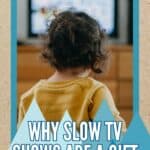Why Slow TV Shows Are a Gift for Kids in a Fast-Paced World
Uncover the benefits of incorporating slow TV shows into your child's screen time routine and witness firsthand how it provides a much-needed counterbalance to today's hyper-fast and overstimulating media landscape.

Play. Learn. Thrive.™ only endorses products we authentically love and use. Some of the product links in this post may be affiliate links. That means that if you click them and make a purchase, this site makes a commission. Play. Learn. Thrive.™ is also an Amazon Associate. As an Amazon Associate, we earn from qualifying purchases. It will have no impact on the price you pay or the experience of your purchase.
Before we dive in, here’s a little about me so you know you’re getting advice from someone who’s been in the trenches! I’m Alanna Gallo, a former teacher with a master’s in education who saw firsthand how kids were losing confidence, independence, and their natural love of learning. I left the classroom to help parents raise curious, capable, and screen-conscious kids in a world that doesn’t make it easy. My work has been featured in major media outlets, and I’m here to give you real, research-backed advice—without the guilt trips or unrealistic expectations.
In a world where everything moves at lightning speed—from the way we consume content to the way we raise our children—it’s easy to overlook the power of slowness. We live in an era of quick cuts, overstimulating visuals, and hyper-fast storytelling that keeps kids glued to screens but leaves little room for deep engagement or reflection.
But what if we chose a different approach? What if, instead of overstimulating media, we introduced our children to something radically different—something slower, more intentional, and truly aligned with how kids learn and process the world?
Enter slow TV for kids—a concept that runs counter to the rapid, attention-fracturing media that dominates children’s entertainment today. And yet, slow TV has the potential to be a game-changer, offering children a more natural, mindful way to experience media while supporting cognitive and emotional development.
The Problem With Fast-Paced Children's Media
Before diving into the benefits of slow TV, it’s important to understand what makes mainstream children’s programming problematic.
Most kids' shows today are fast-cut, high-energy, and designed for passive consumption. The average children's program uses quick edits, loud sound effects, exaggerated facial expressions, and unpredictable changes in scene and pace. These techniques, originally developed to capture fleeting attention spans, have now become the norm in children’s entertainment.

But research suggests that this style of media isn’t doing kids any favors. Studies have shown that fast-paced cartoons can negatively impact executive functioning—the cognitive skills that help children regulate emotions, pay attention, and think critically. One landmark study found that just nine minutes of watching a fast-paced cartoon impaired preschoolers’ ability to focus and solve problems compared to children who engaged in a calmer activity.
Why? Because fast-cut media doesn’t allow for natural processing time. It overstimulates without giving children the space to reflect, imagine, or engage deeply with what they’re watching. And over time, this type of media can train young brains to expect instant gratification, making it harder for kids to develop patience, problem-solving skills, and real-world attention spans.
What is Slow TV for Kids?
Slow TV takes the opposite approach.
Instead of bombarding children with rapid edits and high-energy sequences, slow TV embraces long, unbroken shots, gentle pacing, natural sounds, and simple storytelling.

Imagine a quiet, lingering shot of a caterpillar inching across a leaf. A child watching this might lean in closer, noticing how its tiny legs move, how it arches its back before taking each step, how the leaf gently sways under its weight. Instead of being rushed from one scene to the next, the child has time to observe, wonder, and engage with the experience on their own terms.
Best Slow TV Shows for Kids
If you’re looking for children’s shows that embrace slow storytelling, gentle pacing, and meaningful content, here are some excellent choices:
- Bluey (Australia) – While slightly faster than traditional slow TV, Bluey stands out for its natural dialogue, real-world pacing, and emotional depth. It gives children time to absorb each story without overwhelming them.
- Sarah & Duck (UK) – A beautifully animated show with slow, thoughtful storytelling, subtle humor, and a calm, endearing tone that invites children to wonder about the world.
- Mister Rogers' Neighborhood (USA) – The ultimate example of mindful, slow television. Mr. Rogers spoke directly to children, allowing time for reflection, curiosity, and emotional learning.
- Daniel Tiger’s Neighborhood (USA) – As a modern-day tribute to Mister Rogers, Daniel Tiger follows a gentle, predictable structure with simple songs that reinforce emotional and social lessons.
- Tumble Leaf (USA) – A visually stunning Amazon Prime original featuring a quiet, curious fox named Fig who explores the world through play and discovery. Each episode moves at a steady, soothing pace, mirroring the way children naturally learn.
- Trash Truck (USA) – A heartwarming, beautifully animated Netflix show about a little boy and his best friend—a kind, gentle garbage truck. The slow, slice-of-life storytelling and natural dialogue make this a calming watch.
- Little Bear (Canada) – A classic, timeless show that follows the simple adventures of Little Bear and his animal friends. The hand-drawn animation and soft, warm narration make it a soothing and nostalgic experience.
- Puffin Rock (Ireland) – Narrated by Chris O’Dowd, this charming Irish series follows a young puffin named Oona on gentle adventures around her coastal home. The nature-based setting and calm narration make it an ideal slow TV choice.

Unlike conventional programming, slow TV doesn't seek to command a child's attention through flashy entertainment—it invites them to engage at their own pace. And this subtle shift can make all the difference.
The Benefits of Slow TV for Kids
1. Encourages Active Engagement Over Passive Consumption
Fast media overwhelms kids with constant new input, leaving little room for active engagement. Slow TV, on the other hand, invites children to think, observe, and process in real time. This type of engagement is more aligned with real-world learning, where children are naturally curious and take time to explore concepts at their own pace.
2. Supports Cognitive Development & Attention Span
By allowing children to focus on one scene for an extended period, slow TV helps build concentration and sustained attention. Instead of expecting something new every few seconds, children learn to appreciate subtle details, an essential skill for critical thinking and deep learning.
3. Promotes Emotional Regulation & Calmness
Ever noticed how children become more hyper after watching fast-paced shows? That's because overstimulating media can create an adrenaline-like effect, leaving kids feeling agitated, restless, and emotionally dysregulated. Slow TV, in contrast, provides a soothing, calming experience that helps children feel grounded, present, and emotionally regulated—similar to the way slow, mindful activities like reading or nature walks do.

4. Fosters Creativity & Imagination
When a show doesn't dictate every second of a child's attention, it creates space for their imagination to take the lead. Watching a slow-moving scene of a boat drifting across a lake, for instance, might spark curiosity—where is it going? Who might be inside? Instead of being spoon-fed a story at breakneck speed, children have time to wonder, question, and expand upon what they see.
5. Encourages Connection to the Real World
Fast media creates an artificial sense of reality where everything is loud, exaggerated, and immediate. Slow TV, by contrast, aligns with the natural rhythm of real-life experiences. A documentary about a garden growing, for instance, mirrors the patience required in real-world gardening. This helps children develop a more realistic understanding of time, patience, and natural cause-and-effect relationships.
Rethinking Screen Time: It’s Not Just About Less, But About Better
As screen-conscious parents, we often focus on reducing screen time altogether. And while limiting screens is important, the quality of content matters just as much as the quantity.
Instead of asking, How much screen time is too much?, we should also ask: What kind of screen time best supports my child’s development?

Slow TV offers a way to make media consumption intentional, beneficial, and aligned with real-world learning. It invites children to slow down, to observe, to imagine, and to engage with the world in a way that fosters deep thinking, calmness, and creativity—a stark contrast to the overstimulation of modern kids’ programming.
And in a world that constantly urges us to go faster, that might just be the most radical thing we can do for our kids.
Inspired by this post? Be sure to subscribe download my free Screen-Free Starter Kit! For more insights and resources on raising confident, lifelong learners, be sure to follow me on Instagram – can't wait for you to join me!







